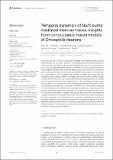Files in this item
Temporal dynamics of Na/K pump mediated memory traces : insights from conductance-based models of Drosophila neurons
Item metadata
| dc.contributor.author | Megwa, Obinna F. | |
| dc.contributor.author | Pascual, Leila May | |
| dc.contributor.author | Günay, Cengiz | |
| dc.contributor.author | Pulver, Stefan R. | |
| dc.contributor.author | Prinz, Astrid A. | |
| dc.date.accessioned | 2023-06-12T11:30:14Z | |
| dc.date.available | 2023-06-12T11:30:14Z | |
| dc.date.issued | 2023-05-22 | |
| dc.identifier | 287620586 | |
| dc.identifier | c1c88651-320c-4288-addc-bde816a61660 | |
| dc.identifier | 85161065225 | |
| dc.identifier.citation | Megwa , O F , Pascual , L M , Günay , C , Pulver , S R & Prinz , A A 2023 , ' Temporal dynamics of Na/K pump mediated memory traces : insights from conductance-based models of Drosophila neurons ' , Frontiers in Neuroscience , vol. 17 . https://doi.org/10.3389/fnins.2023.1154549 | en |
| dc.identifier.issn | 1662-453X | |
| dc.identifier.other | Jisc: 1124257 | |
| dc.identifier.other | ORCID: /0000-0001-5170-7522/work/137089886 | |
| dc.identifier.other | PubMedCentral: PMC10239822 | |
| dc.identifier.uri | https://hdl.handle.net/10023/27778 | |
| dc.description | Funding: This work was supported by a Royal Society Research Grant to SP (RG150108), Collaborative Research Grant funding by the Halle Institute for Global Research at Emory University and University of St Andrews to SP and AP, a Wellcome Trust Seed Award to SP (105621/Z/14/Z), a Emory Computational Neuroscience Fellowship stipend to OM, support from Emory University’s Graduate Division of Biological and Biomedical Sciences and from the George W. Woodruff Fellowship for LP, and VPASA Seed Grant funding at Georgia Gwinnett College awarded to CG. | en |
| dc.description.abstract | Sodium potassium ATPases (Na/K pumps) mediate long-lasting, dynamic cellular memories that can last tens of seconds. The mechanisms controlling the dynamics of this type of cellular memory are not well understood and can be counterintuitive. Here, we use computational modeling to examine how Na/K pumps and the ion concentration dynamics they influence shape cellular excitability. In a Drosophila larval motor neuron model, we incorporate a Na/K pump, a dynamic intracellular Na+ concentration, and a dynamic Na+ reversal potential. We probe neuronal excitability with a variety of stimuli, including step currents, ramp currents, and zap currents, then monitor the sub- and suprathreshold voltage responses on a range of time scales. We find that the interactions of a Na+-dependent pump current with a dynamic Na+ concentration and reversal potential endow the neuron with rich response properties that are absent when the role of the pump is reduced to the maintenance of constant ion concentration gradients. In particular, these dynamic pump-Na+ interactions contribute to spike rate adaptation and result in long-lasting excitability changes after spiking and even after sub-threshold voltage fluctuations on multiple time scales. We further show that modulation of pump properties can profoundly alter a neuron’s spontaneous activity and response to stimuli by providing a mechanism for bursting oscillations. Our work has implications for experimental studies and computational modeling of the role of Na/K pumps in neuronal activity, information processing in neural circuits, and the neural control of animal behavior. | |
| dc.format.extent | 18 | |
| dc.format.extent | 2628216 | |
| dc.language.iso | eng | |
| dc.relation.ispartof | Frontiers in Neuroscience | en |
| dc.subject | Sodium equilibrium potential | en |
| dc.subject | Motor neuron | en |
| dc.subject | Drosophila larvae | en |
| dc.subject | Intrinsic excitability | en |
| dc.subject | Sodium potassium pump | en |
| dc.subject | QH301 Biology | en |
| dc.subject | NDAS | en |
| dc.subject | MCC | en |
| dc.subject.lcc | QH301 | en |
| dc.title | Temporal dynamics of Na/K pump mediated memory traces : insights from conductance-based models of Drosophila neurons | en |
| dc.type | Journal article | en |
| dc.contributor.sponsor | The Royal Society | en |
| dc.contributor.sponsor | The Wellcome Trust | en |
| dc.contributor.institution | University of St Andrews. Organic Semiconductor Centre | en |
| dc.contributor.institution | University of St Andrews. School of Psychology and Neuroscience | en |
| dc.contributor.institution | University of St Andrews. Centre for Biophotonics | en |
| dc.contributor.institution | University of St Andrews. Institute of Behavioural and Neural Sciences | en |
| dc.identifier.doi | https://doi.org/10.3389/fnins.2023.1154549 | |
| dc.description.status | Peer reviewed | en |
| dc.identifier.grantnumber | RG150108 | en |
| dc.identifier.grantnumber | 105621/Z/14/Z | en |
This item appears in the following Collection(s)
Items in the St Andrews Research Repository are protected by copyright, with all rights reserved, unless otherwise indicated.

